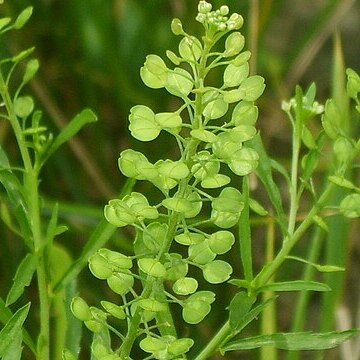Herbs annual or biennial, (5-)10-25(-40) cm tall, puberulent with clavate or capitate trichomes. Stems erect, branched basally and above. Petiole of basal leaves (0.5-)1-3 cm; leaf blade oblong, lanceolate, or oblanceolate, 1.5-4(-5) × 0.7-1.2(-1.5) cm, pinnatifid, sinuate, or dentate. Upper cauline leaves sessile; leaf blade narrowly lanceolate, linear-oblong, or linear, 0.6-3(-4) cm × 1-3(-5) mm, base subauriculate or sometimes cuneate, margin remotely serrate or entire, apex acute to subobtuse. Fruiting pedicels slender, often recurved, 2-4(-5) mm, puberulent only adaxially with clavate or capitate trichomes, slightly flattened or narrowly winged. Sepals caducous, oblong, 0.7-0.8 × 0.3-0.4 mm, glabrous or puberulent, white at margin and apex. Petals absent, or rudimentary, linear, ca. 0.3 mm. Stamens 2; filaments 0.7-0.8 mm; anthers broadly ovate, 0.1-0.2 mm. Fruit broadly elliptic, 2.2-3.1 × 1.7-2.3 mm, widest at middle, apex narrowly winged; apical notch 0.1-0.3 mm; style 0.05-0.15 mm, included in apical notch. Seeds reddish brown, ovate-oblong, 1.1-1.3 × 0.6-0.8 mm, wingless, finely papillate; cotyledons incumbent. Fl. Apr-Aug, fr. May-Sep.
More
A cabbage family herb. It can grow for one or two years. It grows 30 cm high. It has many branches. The lower leaves near the base are divided in short narrow lobes. They are 3-5 cm long by 1 cm wide. The upper leaves are narrow. The flowers are in groups or 20-30. The flowers are small. They have almost no petals.
Steppes, solonetzic soils, roadsides and weed-infested places. Roadsides, slopes, waste places, ravines, plains and fields at elevations of 400-4800 metres in China.
More
It is a subtropical to temperate plant. In Yunnan. In Sichuan.

